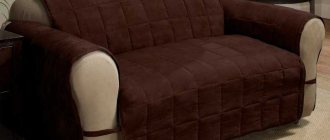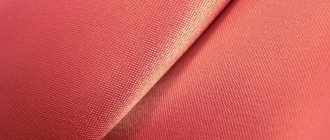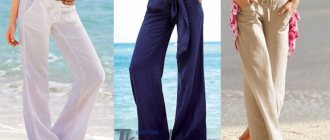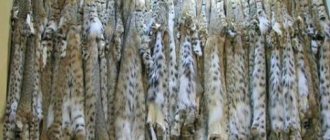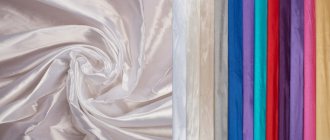Home / By purpose
Back
Published: 07/07/2021
Reading time: 2 min
0
8
A swimsuit is both underwear and an outer suit. The product is in direct contact with the body, and at the same time is visible to others. Therefore, swimsuit fabric must meet strict hygiene, safety and practicality requirements.
- 1 Properties of fabric for a swimsuit
- 2 Names of popular materials
- 3 Tips for choosing
- 4 Conclusion
Properties of swimsuit fabric
When choosing a beach suit, most women look at the color, style, and size. At the same time, the properties of materials are completely ignored. But a lot depends on the fabrics from which swimsuits are made: fit, ease of wear, safety.
Material requirements:
- hypoallergenic: the composition should not contain harmful components that irritate the skin and respiratory system;
- elasticity: a necessary property for a perfect fit;
- dimensional stability: the material should not stretch or shrink;
- UV resistance: protects the body from aggressive rays;
- hygroscopicity: quick drying after getting wet;
- pleasant tactile sensations: the material should not prick or irritate;
- color fastness.
It is equally important to consider what fabric swimsuits are made from in terms of practicality. high-quality textiles - those that last for many years and do not require complex care.
Beach accessories
Necessary beach accessories include pareos, towels and hats. All these accessories are made of textiles.
Pareo
A piece of fabric in the form of a rectangle or square. Wrapped around the hips and waist, serves as a sundress, used to cover the head from the rays of the sun. Depending on the method of tying, a pareo can advantageously emphasize the lines of the figure and effectively hide imperfections, as well as protect the skin from direct sunlight.
Popular fabrics for pareos:
- Silk is a thin, delicate material with a smooth glossy surface. It is made from fibers obtained from silkworm cocoons. The material is natural and expensive.
- Chiffon is a translucent, thin and delicate fabric made from tightly twisted threads. Made from silk, cotton, viscose, polyester and polyamide. Thanks to its structure, it dries very quickly, flows beautifully and forms attractive folds.
- Crepe de Chine is a silk material with a slight sheen. The composition may contain wool and polyester fibers. The peculiarity of crepe is the strong twisting of the threads before weaving.
- Crepe georgette is an airy and elastic material. Made from natural silk. The threads to create this fabric are also twisted, which makes it stiff.
Towels
A properly chosen beach towel absorbs water well and dries quickly.
A necessary beach accessory that will help you warm up after water procedures, serves as a bedding, and sometimes as protection from the sun or from the evening cold. The towel should be soft, hygroscopic and light enough, especially when wet. It’s good when a beach towel dries quickly and does not become rough from water.
Popular materials:
- Cotton is a fabric of plant origin, lightweight, environmentally friendly, safe and hygroscopic.
- Bamboo is an exotic material that is considered less wear-resistant than cotton, but absorbs water well and has a positive effect on the skin.
- Terry is a soft fluffy material with pile, which is formed by loops. Warms well, absorbs moisture and massages the skin.
- Velor is a material with one-sided pile, smooth to the touch and glossy in appearance. Made from cotton, silk and viscose. It looks very elegant and decorative.
Names of popular materials
The fabrics from which swimsuits are made are used in a variety of ways:
- Cotton: not a very practical option for beachwear. It wrinkles, is inelastic, fades quickly, and is spoiled by salt. But it is environmentally friendly, safe, and protects well from ultraviolet radiation. Therefore, it is mainly used for children and expectant mothers;
- supplex: material from which swimsuits are made for recreation and various sports - gymnastics, swimming, figure skating. A distinctive feature is the ability to strongly stretch in both directions. Consists of microfiber and elastane fibers, it is soft, wrinkle-resistant, and wear-resistant;
- polyester: popular textiles are used in economy class models. Quite elastic, resistant to deformation, fading, and creasing. But it does not allow air to pass through well and is spoiled by chlorinated water;
- lycra (spandex, elastane) - synthetic stretchable fibers that are added to the composition of fabrics for beach suits. Very elastic, give a tight fit, correct the figure;
- microfiber: an almost perfect material: stretches well, is breathable, has antibacterial properties. Plus it dries quickly and does not shrink;
- tactel: knitted material with the addition of lycra. Pleasant on the body, dries instantly, corrects the figure, allows air to pass through;
- polyamide: synthetic fabric with a slight sheen. It looks impressive, does not fade, keeps its shape, dries quickly, slims the figure;
- nylon: durable material, therefore it is used mainly in sewing sports swimsuits. Disadvantages: fades, deteriorates from salt and bleach;
- neoprene: new generation synthetics. The main composition is polychloroprene rubber, to which other fibers can be added to improve the qualities of the material. The fabric is dense, waterproof, elastic. Softens shock from temperature changes, is extremely resistant to chemicals, ultraviolet radiation, and mechanical stress. Suitable for sewing beach models, but mainly used for wetsuits.
- header: fabric with a cracked or ribbed effect. It is made from pure cotton, but more often with the addition of elastane, polyester and other synthetic fibers. Thanks to the relief surface, it masks figure flaws.
Fact! There is no separate type of fabric for a swimsuit, which is called a special term. But there is a group of materials that are better suited for a beach or sports suit: mixed, synthetic and semi-synthetic.
What fabrics are swimsuits and swimming trunks made from?
Swimwear is usually made from synthetic fabrics.
Swimsuits and swimming trunks are items of clothing that often come into contact with water (fresh, sea, chlorinated). The material must withstand exposure to sunlight and wind well and retain its shape.
It is synthetic materials that can provide high quality, bright appearance and durability of a swimsuit. However, the requirements for synthetics are high: the fabric should not rub the body, cause allergies, or become rough when wet.
In order for the product to fit well and be easily removed when wet, elasticity or the presence of comfortable ties and straps in the design of the swimsuit is required. Let's take a closer look at the most popular and practical fabrics.
Biflex
Elastic, stretchable knitted fabric. The material consists of connected weft and warp loops, which are loosely connected and give the supplex additional flexibility. The material is completely synthetic, containing nylon, stretchy elastane (or lycra), microfiber and decorative lurex (shiny metallic thread). Fabric Features:
- wear resistance;
- color fastness;
- elasticity;
- does not wrinkle;
- dries very quickly.
The fabric is universal, suitable for sewing two-piece and one-piece swimsuits for any type of water recreation and sports. Stage costumes and gymnastics clothes are also made from supplex.
Lycra
Synthetic elastic material, also known as elastane and spandex. The fabric acquires the ability to stretch due to the special porous structure of the fibers - the segments are connected to each other by peculiar bridges that do not break during stretching. Advantages of the material:
- elasticity and flexibility;
- moisture resistance;
- subtlety;
- ease;
- strength;
- the material does not wrinkle and is pleasant to the touch.
In its pure form, lycra can cause allergies; it is often used as an additional material in the manufacture of mixed fabrics. Lycra holds color very well, which allows you to create bright, colorful swimsuit designs.
Microfiber
Synthetic fabric, which consists of ultra-fine, durable and lightweight fibers. The material adheres very nicely to the skin and is therefore suitable for creating delicate items such as swimwear. Material characteristics:
- availability;
- maintaining shape;
- hygroscopicity;
- strength;
- unpretentiousness.
The structure of the material prevents the appearance of fungi and other microorganisms, so microfiber is not afraid of frequent wetting. The fabric does not tolerate high temperatures.
Polyamide
Synthetic material, which is processed from oil, coal and gas, is very strong and tear-resistant, durable and lightweight. Various wardrobe items are made from polyamide. Material Features:
- dries quickly;
- smooth, pleasant surface texture;
- retains color well;
- ease.
It is believed that a swimsuit made of pure polyamide is extremely impractical, since when stretched it does not restore its shape. If the product contains lycra, the item can last for several seasons while maintaining elasticity. Polyamide is popular as a material for men's swimming trunks.
Polyester
A popular synthetic fabric made from polyester. Polyester can resemble either a veil or a thick raincoat fabric - the appearance depends on the manufacturing technology, the raw materials, and the weave of the threads. Fabric characteristics:
- heat preservation;
- wear resistance;
- ease of care;
- light weight;
- affordable price;
- the material repels water;
- does not absorb foreign odors.
Considered a short-lived option. The fact is that polyester does not tolerate the effects of soda, salt and chlorine and quickly loses its shape. The maximum service life of such a swimsuit is one season. Most often, men's swim trunks are made from this material.
Tactel
Tactel is an elastic knitwear made of very fine fibers. The material may contain acrylic, polyamide, cotton. In contact with the skin, the tactel quickly absorbs moisture and instantly evaporates it, preventing you from feeling discomfort. Material Features:
- dries quickly;
- strength;
- softness;
- breathability;
- ease;
- subtlety;
- elasticity.
The material is very easy to care for. In order for swimsuits to stretch well, lycra is added to the composition.
Tips for choosing
Theoretically, a swimsuit can be made from any type of fabric, but you need to take into account the specifics of this type of clothing:
- Allergy sufferers, children and pregnant women should choose cotton material: completely natural or with synthetic additives;
- if you need a suit for swimming, then the best option is made of polyamide, nylon, textile with lycra additives. They do not stretch or shrink and can withstand exposure to chlorinated water and sea salt;
- A universal option is supplex with lycra. A beach swimsuit made of this fabric retains its color and shape for a long time, is breathable, does not wrinkle, and is resistant to stains. Will last more than one season;
- if you need a suit only for sunbathing, then things made of tactel, microfiber, or reaper are better suited;
- swimsuits for swimming, diving, and wakeboarding must be made of thick neoprene.
How to choose
When choosing fabric for a swimsuit, it is important to consider all the requirements that may apply to it. Therefore, it is worth dwelling on this in more detail.
- Any clothing for the beach should properly protect the body from exposure to sunlight - this is the most important thing.
- The swimsuit must keep its shape well, not deform, not fade, not wrinkle when swimming, and retain its original appearance for a long time.
- The fabric should moderately tighten the body in order to emphasize all the advantages and hide the flaws; after getting wet, this property should remain.
- Swimwear should dry as quickly as possible.
- The product must be strong, elastic and wear-resistant.
The material is pleasant to the body.
There is also a category of swimsuits that is usually called “sports”. The choice of fabric for them is taken with great responsibility, because... it should be like a second skin on the body. Therefore, first of all you need to pay attention to the following properties:
- long service life and resistance to frequent use;
- the fabric should never wrinkle in order to look decent at any performance;
- pleasant to the body, so that there is not a bit of discomfort;
- the skin should be able to allow air to pass through and not sweat.
As for gymnastics suits, athletes prefer supplex, which contains microfiber and lycra. Thanks to this, the swimsuit can stretch up to 3 times. In addition, such fabrics can be easily decorated for various competitions, for example, for rhythmic gymnastics, where clothing should clearly highlight the athlete.
Important! Periodically, lining material is added to the sports swimsuit.
Having information about what the fabric for a swimsuit is called and what properties it has can significantly simplify the time of choosing in the store.
Tailoring at your own request
General properties
All fabrics for swimwear have a number of common properties:
- elasticity;
- ease;
- hygiene;
- softness;
- UV protection;
- ability to retain bright colors for a long time.
Let's look at some of the points in more detail.
All swimsuits fit exactly to your figure. Therefore, the fabric must be elastic and stretch well.
The ideal swimsuit is beautiful and comfortable. Therefore, the fabric must retain the dye well in the fibers. Good material does not fade or fade over time.
An important factor is the lightness of the fabric. It is especially important for those who not only sunbathe on the beach, but swim professionally. Every extra gram of equipment weight can negatively affect the result. Therefore, the material should be as light and invisible as possible.
Swimming clothing should not rub the skin, cause irritation or allergies. The peculiarity of a suitable material is not to retain water, but to remove it as much as possible from the body.
The fabric must be resistant to regular exposure to the sun, moisture, and various reagents added to the water in pools.
Preparing your body for the beach season
Finally, I would like to note how important is the “canvas” or body on which you want to put this or that thing. Even the most expensive swimsuit will not correct the flaws in your figure. You need to remember this and keep yourself in shape.
Photo: https://rotana.net/assets/uploads/2015/11/news_0906734001439565168.jpg
Even half an hour of exercise every day will help get rid of “ears”, tighten your figure, reduce volume and hated folds. Prepare yourself in advance for the swimming season. Use fasting to get rid of extra pounds.
Here is a simple scheme of physical activity, the results of which you will see in just a couple of days: 50 squats, 20 push-ups, pumping the abs in a normal position 50 times, pumping the lateral abdominal muscles 50 times (twisting once on each side), 10 minutes of jumping rope .
Sports models
Particular attention should be paid to gymnastic leotards. The following requirements apply to them:
- wear resistance;
- crease resistance;
- silkiness;
- airflow.
Therefore, most professional athletes prefer supplex. It contains microfiber and elastane. This allows for stretch up to 300%. In addition, the fibers lend themselves perfectly to dyeing and are combined with lurex threads, which allows you to sew bright costumes for performances in rhythmic gymnastics or swimming.
